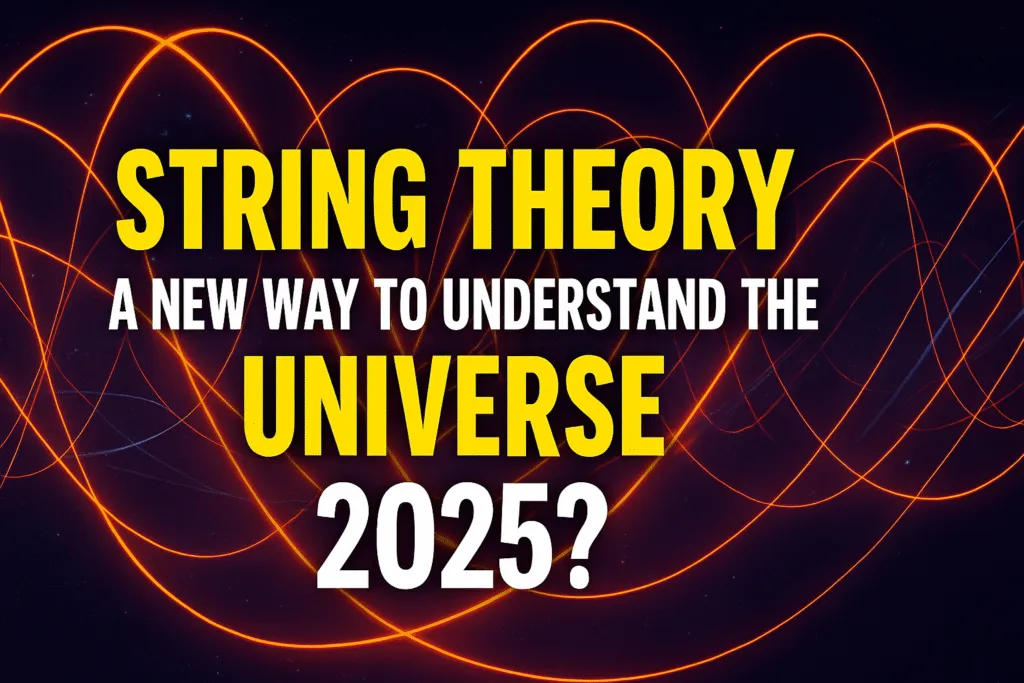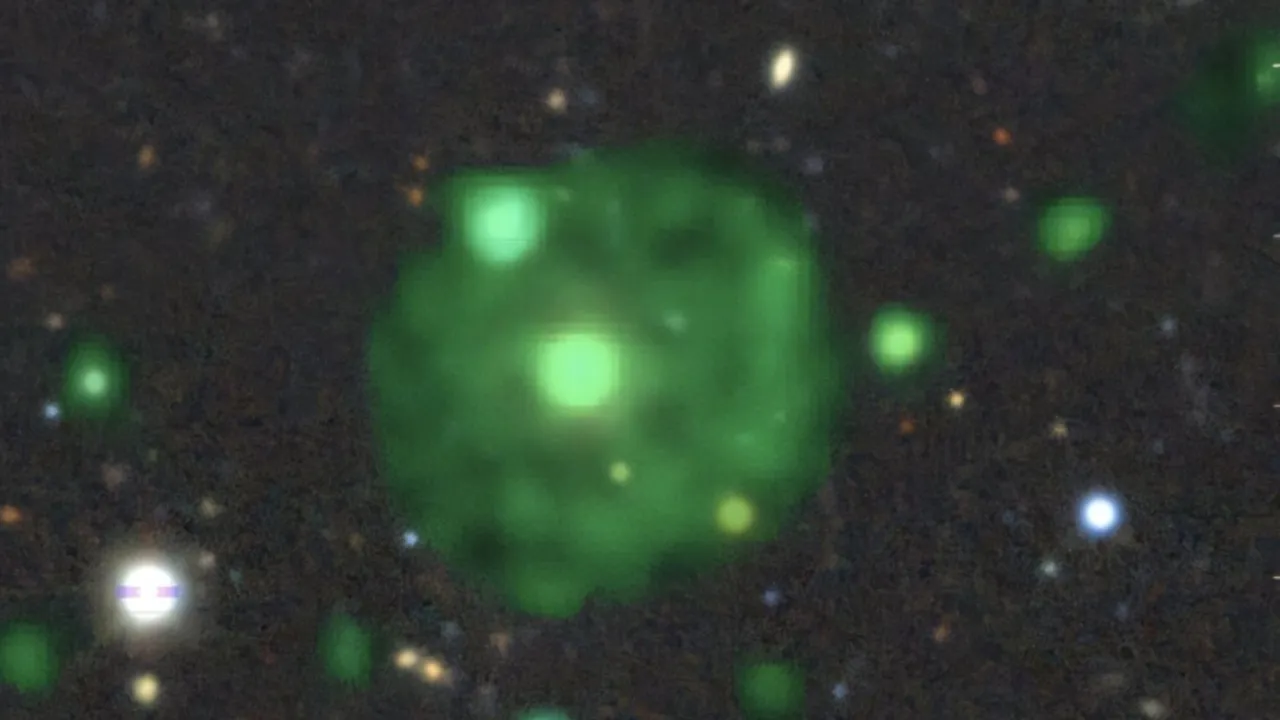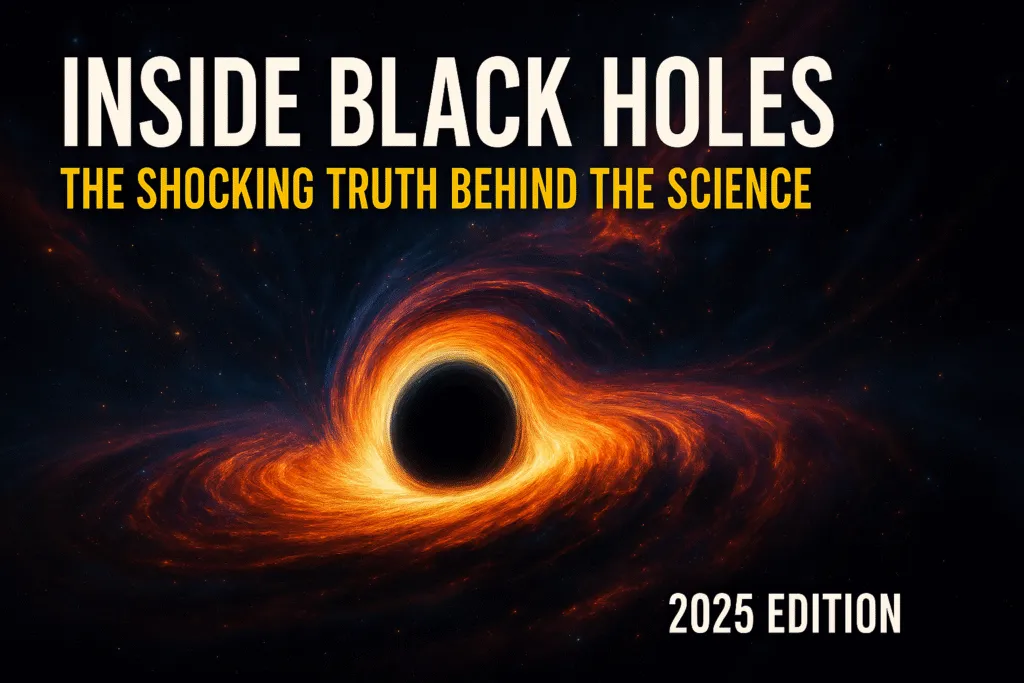Introduction – What Is String Theory?
String theory is a revolutionary concept in theoretical physics that attempts to explain how the entire universe works at its most fundamental level. Instead of viewing particles as tiny point-like objects, string theory proposes that everything in the universe is made up of extremely small vibrating strings. These one-dimensional strings can vibrate in different ways, and each mode of vibration corresponds to a different type of particle. In simple terms, all matter and forces in the universe could be the result of how these strings move and interact with one another.
The idea behind string theory is fascinating because it offers a possible answer to one of the biggest problems in physics: how to unify quantum mechanics and general relativity. Quantum mechanics explains how the smallest particles behave, while general relativity describes how gravity works on a large scale. Until now, these two theories have appeared incompatible with each other. String theory brings them together in one unified framework and offers a new perspective on how space, time, and gravity really function.
Although the concept sounds abstract, it is grounded in serious scientific research and has attracted a lot of attention from physicists around the world. It also introduces new and exciting ideas, such as the existence of extra dimensions that go beyond our familiar three dimensions of space and one dimension of time. Many scientists believe that string theory has the potential to answer fundamental questions about the origin and structure of the universe.
For tech enthusiasts and science lovers, understanding string theory opens up an entirely new way of looking at reality. It encourages curiosity and provides insight into how mathematics and physics can work together to uncover the secrets of the cosmos.
Historical Background – How the Idea Originated
The origins of string theory go back to the late 1960s, when physicists were trying to understand the strong nuclear force that holds protons and neutrons together inside an atomic nucleus. At that time, scientists believed that particles such as mesons might actually be different vibrations of a tiny string rather than point-like objects. This idea was first developed by theoretical physicist Gabriele Veneziano, who created a mathematical formula that surprisingly explained the behavior of particle interactions. This formula became the foundation for what would eventually be known as string theory.
In the early years, string theory was not widely accepted because quantum chromodynamics became the standard explanation for the strong nuclear force. As a result, interest in the string-based approach faded for almost a decade. However, in the 1980s, researchers discovered that string theory could do much more than just describe the strong nuclear force. They realized that it could potentially explain all the fundamental forces of nature, including gravity. This discovery reignited interest and triggered what is known as the “first string revolution.”
This breakthrough occurred when scientists found that string theory naturally includes a particle that behaves like the graviton – a hypothetical particle that mediates the force of gravity. This suggested that string theory could unify all known forces into a single framework. From that point onward, string theory evolved rapidly as researchers developed new models and refined its mathematical structure.
Today, string theory is considered one of the most promising candidates for a “theory of everything.” Its history reflects the ongoing effort of the scientific community to find a deeper and more complete understanding of the universe. Despite challenges and debates, string theory continues to inspire new research and push the boundaries of modern physics.
Basic Principles of String Theory
At its core, string theory proposes that the most fundamental building blocks of the universe are not point-like particles but one-dimensional strings that vibrate at specific frequencies. These strings can be open, with two distinct endpoints, or closed, forming loops. The various vibration modes of a string produce different particles, meaning that what we perceive as particles such as electrons, quarks, or photons are actually different manifestations of the same underlying string. This is the key principle that makes string theory so elegant and powerful.
Another important principle in string theory is that it operates in a multidimensional framework. While everyday experience is limited to three spatial dimensions and one dimension of time, string theory requires additional dimensions for its equations to be mathematically consistent. In most models, the total number of dimensions is ten or eleven. These extra dimensions are believed to be compactified, or curled up, at incredibly small scales, which is why they are not directly observable in our daily lives.
String theory also relies on the principle of supersymmetry. Supersymmetry is a theoretical symmetry that links two different types of particles—bosons and fermions. According to this concept, every known particle has a corresponding superpartner with slightly different properties. Even though these superpartners have not yet been observed, they are an essential part of string theory and help stabilize its mathematical structure.
By combining strings, extra dimensions, and supersymmetry, string theory creates a unified framework that could explain all known forces, including gravity. It provides a way to bridge the gap between general relativity and quantum mechanics, which has been one of the main goals of theoretical physics for decades. Ultimately, the basic principles of string theory aim to describe the true nature of the universe in the simplest and most comprehensive way possible.
Strings vs Elementary Particles – What’s the Difference?
In traditional particle physics, the fundamental constituents of matter are treated as point-like particles with no internal structure. These elementary particles include electrons, quarks, photons, and many others, each with unique properties such as mass, charge, and spin. The Standard Model successfully explains how these point-like particles interact through fundamental forces, but it does not include gravity and leaves several unresolved questions about the nature of the universe.
String theory offers a very different perspective by suggesting that what we call elementary particles are actually tiny one-dimensional strings. Instead of being point-like objects, these strings vibrate in specific ways, and each unique vibration corresponds to a different type of particle. In other words, an electron, a photon, and a quark are not fundamentally different kinds of objects—they are simply different vibrational states of the same type of string.
This distinction has important consequences. If particles are viewed as point-like, it becomes difficult to reconcile quantum mechanics with the curvature of spacetime described by general relativity. However, when particles are treated as strings, their extended structure helps smooth out the extreme effects that occur at very small scales. This allows string theory to incorporate gravity more naturally and potentially resolve inconsistencies that arise when trying to merge quantum mechanics with general relativity.
Another key difference is that the vibrating strings of string theory require the existence of extra spatial dimensions to function properly, while the point-particle view of the Standard Model does not. These extra dimensions become crucial in explaining how strings interact and why certain forces appear the way they do in our four-dimensional experience.
In summary, the key difference between strings and elementary particles lies in their fundamental nature. Strings offer a unifying and flexible framework that could explain all particles and forces as different vibrations of the same basic entity, providing a deeper understanding of the universe.
Extra Dimensions – Why String Theory Needs Them
One of the most fascinating features of string theory is its requirement for extra dimensions beyond the familiar three spatial and one time dimension of our everyday experience. In classical physics, space is described in terms of length, width, and height, and time is treated as a separate dimension. This four-dimensional framework works well for most practical purposes. However, when scientists attempted to build a consistent theory of vibrating strings, they discovered that the equations only make sense if additional spatial dimensions are included.
In most versions of string theory, a total of ten or eleven dimensions are needed in order for the mathematics to work properly. These extra dimensions are not visible in daily life because they are believed to be compactified or curled up into extremely small shapes at the subatomic level. You can imagine them as tiny, tightly rolled structures that exist at every point in space, much like the thickness of a sheet of paper that appears flat from a distance but reveals another dimension when viewed up close.
The presence of these extra dimensions allows string theory to explain differences in particle properties. The way a string vibrates depends not only on its tension and length, but also on the structure of the space through which it moves. When space includes additional compact dimensions, strings can wrap around them or vibrate in directions that aren’t available in ordinary three-dimensional space. These more complex vibration patterns generate a wider variety of particles and interactions.
Without extra dimensions, the elegant structure of string theory would collapse and fail to describe the forces of nature in a consistent way. This is why these hidden dimensions are so essential—they give the theory the flexibility needed to unify gravity with quantum mechanics and provide a deeper insight into the true nature of the universe.
Types of String Theories
When physicists first began exploring string theory, they discovered that there wasn’t just one single version of the theory but several different variants, each with its own unique properties. These different types of string theories arose because strings can be either open (with endpoints) or closed (forming loops), and the mathematics describing their behavior can take slightly different forms. Surprisingly, five consistent versions of string theory emerged: Type I, Type IIA, Type IIB, Heterotic SO(32), and Heterotic E8×E8.
Type I string theory includes both open and closed strings and incorporates a certain kind of mathematical symmetry that leads to specific particle interactions. Type IIA and Type IIB contain only closed strings but differ in the way those strings vibrate and the types of particles they produce. The heterotic versions—SO(32) and E8×E8—are especially interesting because they combine the vibration rules of closed strings with properties from another type of symmetry that comes from higher-dimensional structures, allowing them to generate a very rich set of particle interactions.
For many years, physicists wondered why there were five different string theories and which one might describe our universe. In the mid-1990s, researchers discovered something surprising: all five versions are actually connected and can be considered different limits of a more general framework called M-theory. This realization triggered what is now called the “second string revolution” and led to the idea that the various string theories are just different perspectives of a single, deeper theory.
Understanding the different types of string theories helps illustrate how versatile and powerful the concept of string theory really is. Rather than being a single rigid model, string theory is a flexible framework with multiple formulations, all of which aim to describe the fundamental structure of reality.
Key Concepts: Branes, Supersymmetry, and Dualities
String theory includes several important ideas that help explain how the universe works at its deepest level. Three of the most essential concepts are branes, supersymmetry, and dualities.
Branes (short for “membranes”) are multi-dimensional objects that generalize the concept of strings. While a string is a one-dimensional object, a brane can have two, three, or even more dimensions. For example, a 2-brane is a two-dimensional surface and a 3-brane is a three-dimensional volume. In some versions of string theory, our entire universe might actually be a 3-brane floating in a higher-dimensional space, with particles and forces confined to this brane while gravity can extend into other dimensions.
Supersymmetry is another key element of string theory. It is a theoretical symmetry that links two types of particles: fermions, which make up matter, and bosons, which carry forces. According to supersymmetry, every fermion has a corresponding boson as its superpartner, and vice versa. Even though these superpartner particles have not yet been observed in experiments, supersymmetry is essential for making the equations of string theory consistent and helps prevent mathematical problems that would otherwise break the theory.
Dualities are powerful mathematical relationships that show how different versions of string theory are connected. They reveal that two theories that seem completely different may actually describe the same physical phenomena in different ways. This means that a problem that is difficult to solve in one theory might be easier to solve in a dual version. Dualities also helped physicists realize that the five original string theories are actually linked together as parts of a larger theoretical framework.
Together, the concepts of branes, supersymmetry, and dualities give string theory its rich structure and help explain how such a complex theory can still provide a unified description of the universe.
How String Theory Attempts to Unify Gravity and Quantum Mechanics
One of the biggest challenges in physics is the long-standing conflict between general relativity and quantum mechanics. General relativity describes how gravity works on a large scale, such as the motion of planets and the structure of galaxies. Quantum mechanics, on the other hand, explains the behavior of subatomic particles at the smallest imaginable scales. Both theories work extremely well in their own domains, but they become incompatible when applied together, especially in extreme environments like black holes or the very early universe.
String theory offers a promising route toward unifying these two seemingly contradictory frameworks. Instead of treating the fundamental constituents of matter as point-like particles, string theory describes them as one-dimensional strings vibrating at specific frequencies. The key insight is that the mathematical framework of string theory naturally includes a particle that has the exact properties expected of a graviton—the theoretical quantum particle that carries the force of gravity. This means gravity is no longer an external force that has to be added separately to quantum equations; instead, it emerges naturally from the vibrations of strings.
Because strings have a tiny but finite length, they help smooth out the extreme effects that arise from point-like particles interacting at very high energies. This avoids the infinite values that normally appear when trying to combine quantum mechanics with general relativity. In this way, string theory manages to connect the laws of gravity with the laws of quantum physics in a single consistent theory.
Ultimately, string theory attempts to achieve what scientists call a “theory of everything”—a single framework capable of describing all known forces and particles in the universe. While experimental verification remains difficult, its ability to unify gravity and quantum mechanics makes string theory one of the most compelling ideas in modern physics.
Experimental Challenges – Can We Test String Theory?
While string theory is one of the most exciting ideas in modern physics, one of its biggest challenges is that it is extremely difficult to test experimentally. Most versions of string theory operate at energy scales far beyond what any current particle accelerator can reach. The strings themselves are thought to be incredibly small—close to the Planck length—which means that any direct detection of their structure would require technologies far more advanced than what we currently possess.
Another challenge is the existence of extra spatial dimensions. These dimensions are believed to be compactified or curled up at scales too tiny to observe directly. Even if particles interact in these hidden dimensions, the effects would be extremely subtle and difficult to detect using today’s instruments. Scientists have proposed looking for tiny deviations in gravitational behavior at very small distances, but so far, no experiments have produced definitive evidence for extra dimensions or vibrating strings.
In addition, string theory allows for a huge number of possible solutions—often referred to as the “string landscape.” Each solution corresponds to a different way the extra dimensions can be compactified, leading to different sets of physical laws. This makes it difficult to generate clear, unique predictions that can be tested in experiments. Instead of giving one precise answer, string theory provides a range of possibilities, which reduces its predictive power in a traditional experimental sense.
Despite these obstacles, researchers remain optimistic. They are exploring indirect ways to test string theory, such as studying cosmic background radiation, black hole behavior, and even potential patterns in the distribution of galaxies. While direct confirmation may still be far away, many physicists believe that ongoing advances in technology and astronomical observation could eventually provide clues that either support or challenge string theory.
Criticism and Controversies Around String Theory
Despite its elegance and potential, string theory has faced significant criticism and controversy within the scientific community. One of the primary concerns is its lack of experimentally testable predictions. A scientific theory is generally valued for its ability to make clear predictions that can be confirmed or falsified by observation. In the case of string theory, the predicted effects occur at energy levels far beyond the reach of current experiments, leaving critics to argue that it remains more of a mathematical framework than a true physical theory.
Another major criticism is the enormous number of possible solutions within the theory. String theory allows for a vast “landscape” of different universes, each with its own set of physical laws. Some physicists believe this makes it impossible to identify which version, if any, corresponds to our own universe. The lack of a unique and definitive solution reduces the predictive power of the theory and raises questions about its scientific usefulness.
Some researchers also argue that the strong focus on string theory in the theoretical physics community has limited the exploration of alternative ideas. They worry that promising approaches to quantum gravity, such as loop quantum gravity or causal set theory, have received less attention and fewer resources because string theory has dominated the conversation for decades.
Additionally, there is a broader philosophical debate about whether a theory that cannot be tested by current or near-future experiments should still be considered part of physics. Supporters of string theory point out that many great scientific theories began as purely theoretical ideas and were only tested years or even decades later. Critics, however, argue that without testable predictions, string theory risks drifting too far from empirical science.
Overall, the controversies surrounding string theory highlight both its ambitious goals and the serious challenges it faces as a framework for understanding the universe.
Current Developments and Research
In recent years, research into string theory has continued to evolve, driven by both new mathematical insights and connections to other areas of physics. One of the most active areas involves studying how different string theories are connected through dualities—mathematical relationships that reveal how seemingly different theories can actually describe the same physical phenomena. These dualities have allowed physicists to solve complex problems that were previously unsolvable in one version of the theory by translating them into another.
Another exciting development involves the study of holography, particularly the AdS/CFT correspondence. This idea suggests that certain theories of gravity in a higher-dimensional space can be equivalent to quantum field theories operating on the lower-dimensional boundary of that space. The AdS/CFT correspondence is widely viewed as one of the most promising links between string theory and observable physics. It has been used to make progress in understanding black hole thermodynamics, high-energy particle interactions, and even aspects of condensed matter physics.
Researchers are also looking for indirect observational evidence that could support string theory. For example, certain cosmological models based on string theory predict specific patterns in the cosmic microwave background radiation or unique signatures from early-universe inflation. Although no decisive evidence has been found so far, upcoming telescopes and space missions may provide new data that could help confirm or challenge these predictions.
On the mathematical side, string theorists continue to explore the geometry of extra dimensions and the properties of branes. These investigations have led to new connections with pure mathematics, particularly in areas such as algebraic geometry and topology. These cross-disciplinary links reinforce the idea that string theory not only aims to explain the physical universe but also contributes to deeper understanding in mathematics itself.
Overall, current research in string theory remains vibrant, with scientists striving to bridge the gap between deep theoretical frameworks and testable predictions.
Why String Theory Matters – Its Impact on Modern Physics
String theory matters because it offers a bold and comprehensive attempt to answer some of the deepest questions in physics. Even though it remains unproven, string theory has already had a significant impact on the way scientists think about the universe and the fundamental laws that govern it. One of its most important contributions is that it provides a potential framework for unifying all the known forces of nature—including gravity—into a single, coherent theory. This has pushed researchers to explore entirely new ways of understanding the structure of reality.
Another reason string theory is important is its influence on mathematics and theoretical research. The complex ideas developed within string theory have led to breakthroughs in various fields of pure mathematics, such as geometry and topology. These discoveries have not only advanced mathematical knowledge but have also helped physicists build more refined models of the universe. In this way, string theory has become a bridge between physics and mathematics, encouraging collaboration and innovation across disciplines.
String theory has also inspired new ideas about the nature of space and time. Concepts such as extra spatial dimensions, branes, and holography have fundamentally changed how physicists think about the universe. These ideas have led to new approaches in fields such as cosmology and black hole physics, where traditional theories fall short. Even if string theory is eventually replaced or modified, many of its core concepts are likely to influence future theories of fundamental physics.
Finally, string theory promotes a culture of curiosity and exploration. It encourages scientists to ask big questions and consider possibilities that go far beyond current experimental limits. This open-minded approach is essential for progress in science and helps drive new discoveries.
In short, string theory matters not only for its potential to unify the laws of physics but also for its broader impact on scientific thinking, mathematical research, and our understanding of the universe.
Conclusion – Can String Theory Truly Explain the Universe?
String theory remains one of the most ambitious and compelling ideas in modern physics. By proposing that everything in the universe is made of tiny vibrating strings, it offers a unified framework that could potentially explain all fundamental forces and particles—including gravity, which has long resisted incorporation into quantum theory. Unlike traditional models that treat particles as point-like, string theory provides a more flexible structure that smooths out inconsistencies and opens the door to a “theory of everything.”
However, whether string theory can truly explain the universe is still an open question. The biggest hurdle is the lack of experimental evidence. The energy scales required to directly test string theory are far beyond current technological capabilities, and indirect tests have yet to produce conclusive results. Moreover, the theory’s vast landscape of possible solutions makes it difficult to identify one definitive version that describes our universe.
Despite these challenges, string theory continues to drive progress in theoretical physics and mathematics. It has introduced groundbreaking concepts such as extra dimensions, supersymmetry, branes, and holographic duality. Even if string theory ultimately requires modification or replacement, many of its core ideas are likely to influence future theories and deepen our understanding of the universe.
At its heart, string theory represents the natural human desire to search for a deeper and more unified explanation of reality. It invites us to think beyond the limits of current knowledge and explore how all parts of the universe might be connected. Whether or not it is the final answer, string theory remains a powerful and inspiring step toward uncovering the true nature of the cosmos.
Also Read: Shah Rukh Khan Silences Troll With One Savage Line After Being Told “You Should Retire”
FAQs
Q1. What is string theory in simple terms?
String theory suggests that the smallest building blocks of the universe are not point-like particles but tiny strings that vibrate in different ways. Each vibration creates a different type of particle, giving rise to all matter and forces in the universe.
Q2. Why do scientists need extra dimensions in string theory?
String theory requires extra spatial dimensions to make the equations work properly. These extra dimensions are believed to be compactified and too small to observe, but they allow strings to vibrate in ways that create different particles and forces.
Q3. Can string theory be tested experimentally?
At present, direct testing is extremely difficult because the strings are incredibly small and require energy levels far beyond what current technology can produce. Scientists are exploring indirect methods such as studying cosmic radiation and black hole behavior.
Q4. What is the main goal of string theory?
The main goal is to unify all fundamental forces—including gravity, electromagnetism, and nuclear forces—into a single theoretical framework, often called a “theory of everything.”
Q5. What are branes in string theory?
Branes are multi-dimensional objects that generalize the idea of one-dimensional strings. For example, a 3-brane has three spatial dimensions. Some theories suggest that our entire universe might be a 3-brane within a higher-dimensional space.
Q6. What is supersymmetry and why is it important in string theory?
Supersymmetry is a theoretical symmetry between matter particles (fermions) and force carriers (bosons). It helps stabilize string theory’s equations and is a core feature of many string theory models.













